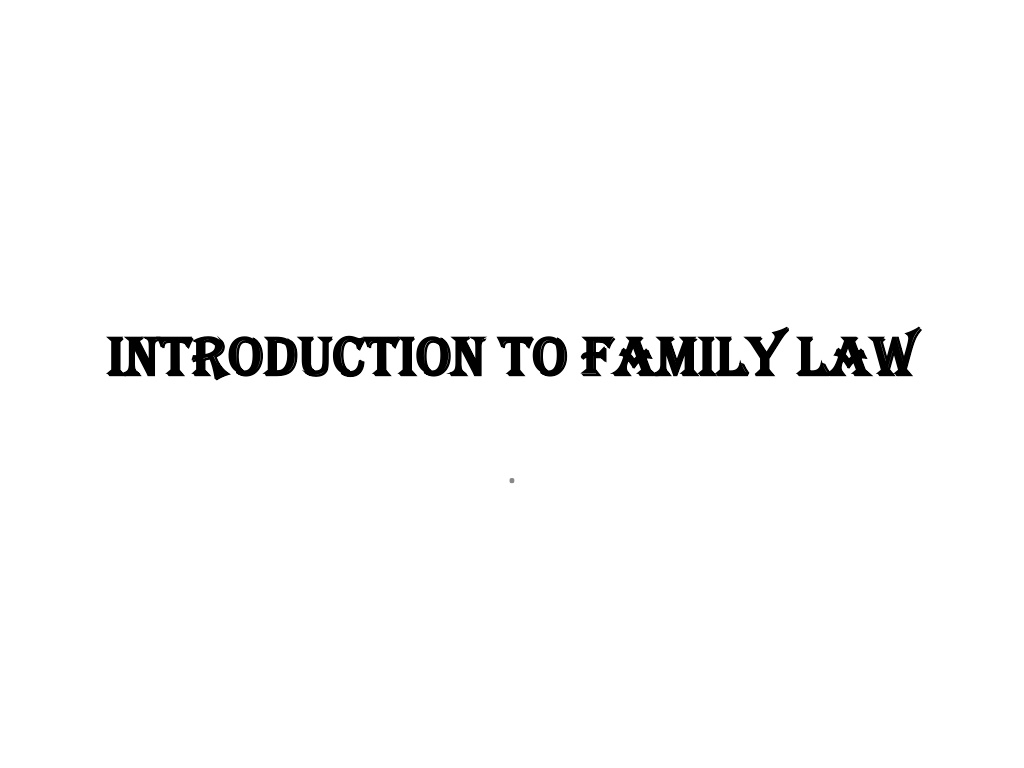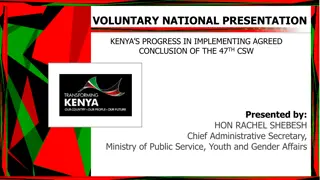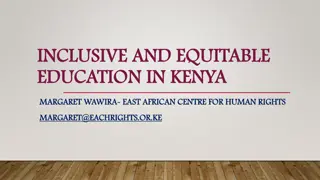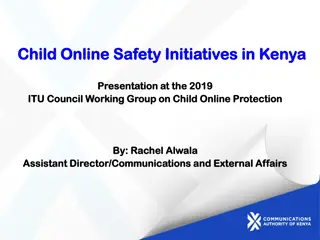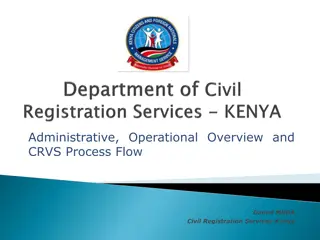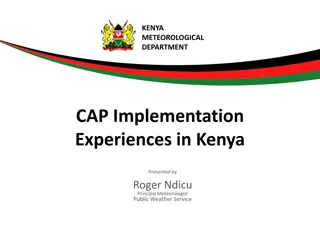Introduction to Family Law in Kenya
Family law in Kenya covers various aspects including types of marriages such as Christian, civil, African customary, Islamic, and Hindu marriages. Christian marriages are conducted under specific acts and are monogamous in nature, while civil marriages involve legal procedures at government registries. Both types require specific procedures for solemnization and registration of marriage.
Download Presentation

Please find below an Image/Link to download the presentation.
The content on the website is provided AS IS for your information and personal use only. It may not be sold, licensed, or shared on other websites without obtaining consent from the author.If you encounter any issues during the download, it is possible that the publisher has removed the file from their server.
You are allowed to download the files provided on this website for personal or commercial use, subject to the condition that they are used lawfully. All files are the property of their respective owners.
The content on the website is provided AS IS for your information and personal use only. It may not be sold, licensed, or shared on other websites without obtaining consent from the author.
E N D
Presentation Transcript
introduction to family law introduction to family law .
Introduction to family law Introduction to family law What is a family What is a family A family as a set of parents and children or of relations living together or if not the members of a household, especially the parents and their children. In the traditional African context, the family was much wider and included distant relatives and other persons related through marriage. Members of one clan or even related clans were, in many instances, referred to as one family.
Introduction to family law Introduction to family law Types of marriages Types of marriages There are five different types of marriage in Kenya. These are: Christian, civil, African customary, Islamic, and Hindu marriages
Introduction to family law Introduction to family law Christian Marriages Christian Marriages These are contracted under the Marriage Act or the African Christian Marriage and Divorce Act. They are conducted in church by an authorized church minister in a licensed place. Under the African Christian Marriage and Divorce Act, they are exclusive to Christians while under the Marriage Act even non-Christians can contract a marriage. The names of licensed church ministers and venues are published in the Kenya Gazette regularly. There is no requirement for parental consent. They are monogamous in nature. Anyone of 18 years and above can contract a marriage. Notice of intention to marry is given in accordance with the requirements of the particular church.
Introduction to family law Introduction to family law Civil Marriages Civil Marriages These are contracted under the Marriage Act, without necessarily involving a church minister. They may be conducted either at the Attorney General s Office or other authorized government registry of marriages, such as the District Commissioner s office. They are monogamous in nature.
Introduction to family law Introduction to family law Civil Marriages Civil Marriages Notice of intention to marry is given 3 months before the date of the intended marriage. The registrar enters it into the marriage notice book, which is open for public scrutiny and publishes the notice by affixing it outside his or her door for the entire period of the notice, which is 3 months. Anyone with an objection is allowed to lodge an objection and the marriage cannot thereafter take place without the objection being lifted by the High Court. After the expiry of 21 days after the issue of the notice, the registrar issues a certificate authorizing the marriage. After the parties have been pronounced man and wife, they sign a certificate. The marriage must be witnessed by at least 2 people who must also countersign the marriage certificate together with the registrar.
Introduction to family law Introduction to family law Hindu Marriages Hindu Marriages These are conducted under the Hindu Marriage and Divorce Act and are exclusively for people professing the Hindu faith. They are monogamous in nature. Marriages may also be arranged by the parents. The age of marriage is 18 for men and 16 for women. However, until the girl is 18 she can only marry with the consent of the parents. Once married, both parties have the right to each other s company and companionship. This includes the right to share a common matrimonial home, the right to sexual intercourse, the wife s right to use her husband s name, and the preservation of marital secrets. The wife also has a right to maintenance.
Introduction to family law Introduction to family law Islamic Marriages Islamic Marriages Islamic marriages are conducted under the Mohammedan Marriage, Divorce and Succession Act. They are potentially polygamous except among the Shia Imami Ismailis who are monogamous. Most marriages are arranged by the parents and gifts exchanged during the agreement are returnable if the marriage does not take place. The age of marriage is the age of puberty, that is to say 14 for girls and 16 for boys. Under Islamic law, the wife is entitled to mahar, or dowry, from the husband; maintenance as long as she is obedient; and consortium
Introduction to family law Introduction to family law African Customary Marriages African Customary Marriages These are conducted under the customary law of the individuals in question. They are potentially polygamous. Some Marriages were arranged by the parents, known as betrothals. Payment of bride price follows after which the marriage is contracted. Amongst the Kikuyu, Embu and Meru, unless elaborate ceremonies such as ngurario are performed, there is no valid customary marriage. People are prohibited from marrying within certain prohibited degrees of affinity, and in certain communities marrying blood relatives is absolutely forbidden. Once married, both parties are entitled to consortium;
Introduction to family law Introduction to family law African Customary Marriages African Customary Marriages The husband must provide a home for his wife and children; the wife has a duty to obey the husband; The husband has an unfettered right to sexual intercourse with his wife and it may not be denied except in instances when it is taboo; The husband can claim damages from any man who has sexual intercourse with his wife; the man must pay dowry to his parents-in-law; and the wife has a duty to tend the farm and to bear children and take care of them.
Introduction to family law Introduction to family law Separation and Divorce Separation and Divorce Separation is the temporary parting of a married couple either by order of the court or by mutual agreement. Divorce, on the other hand, is the legal dissolution of a marriage through procedures laid down in the law governing the marriage. Each system of marriage specifies grounds for separation and divorce.
Introduction to family law Introduction to family law Christian and civil marriages Christian and civil marriages Christian marriages may be dissolved by a resident magistrate s court while civil marriages can only be dissolved by the High Court. The party seeking the divorce files a special lawsuit called divorce petition, setting out the grounds for the divorce. The person petitioning the court is known as the petitioner while the person being petitioned against is known as the respondent
Introduction to family law Introduction to family law Before filing a divorce petition, the spouse seeking divorce must satisfy the following conditions: The parties must have been married for at least 3 years, unless he or she can show that the marriage poses certain exceptional hardships; Both parties must be ordinarily resident in Kenya, provided that where the husband is not ordinarily resident in Kenya, the wife may present a petition if she has been resident in Kenya for at least 3 years;
Introduction to family law Introduction to family law The petitioner must show that he or she has not contributed to the commission of the matrimonial offence or turned a blind eye to it (fro example by resuming sexual relations after adultery); It must be shown that both parties have not colluded to bring the divorce petition (it is against public policy in Kenya to divorce by agreement) It must be shown that there are no other pending petitions involving both parties in any court in Kenya.
Introduction to family law Introduction to family law Islamic Marriages Islamic Marriages Under Islamic law, there may be a judicial divorce or an extra-judicial divorce. The judicial divorces are heard by the High Court in accordance with Islamic law. The grounds recognized under Islamic law are: desertion by the husband for at least 5 years; failure by the husband to provide maintenance for the wife and children;
Introduction to family law Introduction to family law Imprisonment of the husband for at least 7 years; failure by the wife to perform marital obligations; impotence, insanity or cruelty of the husband; capture of the husband by enemies during wartime Extra-judicial divorce is however the most common. Where the wife is on the wrong, the husband is supposed to warn her and guide her on the right path. If she persists in her conduct, he can divorce her. Where reconciliation fails, he or she may resort to divorce. This can be done by the wronged party pronouncing the 145 word talak 3 times at an interval of 40 days. Upon the third talak, the marriage is deemed dissolved.
Introduction to family law Introduction to family law Hindu Marriages Hindu Marriages Under Hindu law parties may undergo judicial separation and, eventually, divorce if they fail to reconcile within two years. The grounds are the same as those of Christian and civil marriages. It is also possible for the parties to seek divorce without first obtaining the 2-year separation.
Introduction to family law Introduction to family law Customary Marriages Customary Marriages Divorce under customary law is rare because parties are only permitted to divorce when the marriage has broken down to such an extent that further cohabitation or reconciliation is impossible. Judicial divorce may be obtained by filing a petition in a magistrate s court. The court will decide on the petition based on the relevant customary law.
Introduction to family law Introduction to family law The grounds for divorce include: Refusal of either party to have sexual intercourse with the other without good reason; witchcraft by either party; habitual theft by either party; willful desertion, which is rare; incest;
Introduction to family law Introduction to family law Excessive physical beating either by the man or the woman; Failure by the husband to maintain his wife and children; laziness, especially of the wife; Adultery by the wife (the husband cannot commit adultery); Impotence on the part of the husband; Barrenness (in some communities)
Introduction to family law Introduction to family law Extra-judicial divorce may be obtained by: Chasing the wife away and informing his family and her family; The wife running away without being chased away; or Where the wife s parents take her away for one of many possible grounds (for Example, that dowry has not been fully paid or where the husband has been excessively violent)
